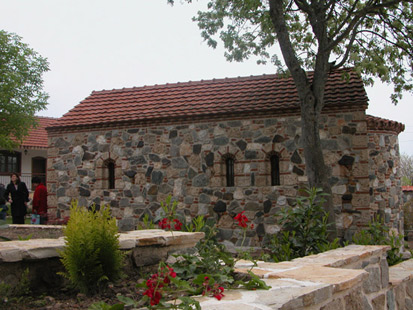Along the way that turns aside from Bansko spa towards the centre of the homonymous village, the chance traveller could not even suppose that he is to come across the recently founded male monastery, which, just as the ancient sacral site a fifteen-minute walk from the monastery, is dedicated to the Forty Holy Martyrs of Sebaste. At the foot of the slopes of Belasica, in a region mildly elevated on a hilly plateau above the Strumica Valley, for centuries the name of the place "Forty Holy" has been preserved among the population. Today the renewal of monastic life here bears witness again to the deep spiritual roots of Orthodox monasticism in the history of the Strumica diocese.

From History
The archaeological site of the newly discovered church, dedicated to the Forty Holy Martyrs of Sebaste as well, speaks of it having been built as an episcopal shrine. As for the period of time when the church had such a function, further researches are to reveal it. Whether this was prior to or after the construction of the second, that is, the third Vodoča church, for the time being it is not determined. If we consider the veneration of the Forty Holy Martyrs of Sebaste – represented on the fresco painting in the Holy Sophia in Ohrid and on the damaged fresco painting of the Vodoča church, which date back in the mid 11th century – the construction style and the objects found in the tombs right next to the church, we will get the answer about the linkage of this church in Bansko with the Vodoča churches, as well as with the one in Strumica, dedicated to the Fifteen Holy Hieromartyrs of Tiberiopolis. Nevertheless, it is known for certain that the Bansko church was not an episcopal one in the time of episcope Manuel of Strumica, who lived in the second half of the 11th century. Therefore it can be postulated with some certainty that the church in Bansko was most probably built during the reign of the Komnenos dynasty, when, after the fall of Samuel's empire, in Macedonia Byzantine influence was reinforced again and many important sacral edifices were built.
From Monastery Life
The wide metal gates lead directly into the monastic yard. Under the shade of the large trees the contours of the old and the new come into sight. On 1 September 2001, the monastery welcomed its first monks, who came from the Vodoča monastery. In less than two years new residential quarters have been built and the small church has been reconstructed, consecrated to two saints named Parasceva: to the Venerable one, whose relics in the present are housed in Iaşi (in Romania) and to the Venerable Martyr Parasceva (of Rome). In the rooms of the old monastery quarters the small brotherhood has started growing mushrooms as the only opportunity to organise an economy of its own which would satisfy the small material needs of monastic life. In the most quiet and most picturesque part of the complex a new icon painting atelier has been built, in which the tradition of the Vodoča icon painting school will continue its life.
Besides, the village has no separate church and so all its spiritual needs are met in the monastery church. Village children gather daily at the drinking fountain in the monastery yard. The brotherhood is still making efforts to create favourable conditions for maintenance of the hesychastic typikon . The monastery, in actual fact, is of skete character: no more than four in the brotherhood. The monks occupy themselves with handicraft: knitting prayer ropes, making small wooden crosses, mounting icons. Since November 2004, in the Bansko monastery of the Holy Forty Martyrs of Sebaste, the “Saint Theodosius of Sinai” printing house with a bookbinder's shop has been actively working. The monastic brotherhood, which in its monastic struggle here has undertaken the training in the printer's skill as well, with attention and zeal has dedicated itself to the daily process of making diaries, books, notebooks, calendars, brochures, catalogues, and numerous other office materials, which assist the monastery economy, and whose contribution for its part represents a valuable input in the publishing activity of the diocese. The first book printed in the Bansko monastery printing house was Škola za Isihazam (A School of Hesychasm) Book 1 by Metropolitan Nahum of Strumica, an edition of the Veljusa monastery of the Most Holy Theotokos Eleusa.
All well-intentioned visitors and pilgrims are welcome. The mild smiling face of the monastery superior father Agathon will invite you to a cup of coffee with a piece of Turkish delight or a glass of spring water if you wish to have a rest on the wooden benches under the shade behind the altar apse of the church. Perhaps you will also have the opportunity to see some of the excellent icons by the hieromonk -iconpainter living here... so that you leave enriched with a new experience of the Byzantine aesthetics.